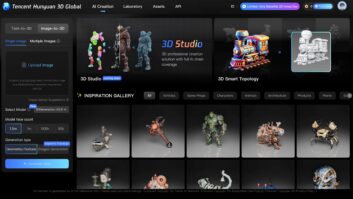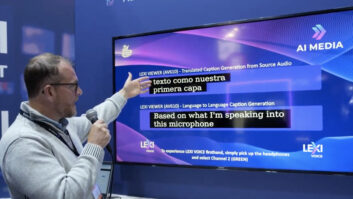Screen Subtitling Systems has launched a new depth-mapping module for its 3D subtitling product, 3Ditor, and warned that poor placement of text and graphics could ruin the 3D experience, writes David Fox.
Captions, graphics and text can be difficult to get right for 3D, and Screen warned that unless the industry resolves these issues it could sabotage the entire market.
“With 2D material, where subtitling remains in the whole along the bottom of the screen, the only consideration would be, let’s say, the style of background it sits against or whether you opt for outlined or shadowed text,” said Gary Glover, Screen’s Sales and Marketing Director.
“Incorrectly placed subtitles in 3D footage however may not only destroy the 3D illusion for the viewer – sometimes resulting in them feeling unwell – but can in fact completely ruin the creative intentions of the director too.
“When we have spoken to directors, it is apparent that subtitles for 3D material are as important to the creative process as many other elements. In fact we’ve even been involved in discussions around establishing the role of a specific stereographer whose job it would be to place subtitles as a stage within that creative process.”
Screen undertook extensive research into the complications arising from adding additional material like subtitles to a 3D scene, which led to the development of 3Ditor, a sophisticated subtitling preparation and review system for 3D.
However, 3D subtitle placement is a complex process and the additional challenges presented by the apparent disparity of objects in 3D footage add further scope for error.
“As we view 3D differently to 2D, it’s no longer acceptable to leave the subtitles in a fixed position running along the bottom of the frame – so where should they be placed and will the position be ‘safe’?,” he asked.
“As we’re not just dealing with X and Y dimensions in 3D but must also consider the depth on the Z axis, we run the risk of subtitles clashing with other objects because of their apparent depth in the image we’re viewing.
“The placement of subtitles in the footage, with a view to appeasing the physiological aspect of viewing 3D imagery, coupled with creative positioning to enhance the on screen action just increases the chances of them getting in the way.”
Manual placement and ensuring that subtitles are not bumping in to any other objects can prove laborious and be prone to oversight. The new disparity-mapping module for 3Ditor takes away that guesswork and helps eliminate human error.
It analyses each 3D frame and generates real-time disparity data. From this a pin-view of the frame can be displayed, graphically interpreting the apparent depth (or disparity) of objects, which could make it useful for much more than just positioning subtitles.
“The pin-view [pictured left] can be rotated and the subtitle can then be placed against it, accurately illustrating whether the subtitle is in its own free space or is encroaching on areas apparently occupied by other objects,” he explained.
“If a director is working with budgets equalling those of Avatar, then the production team has the money and therefore time to pay intricate attention to subtitling, but that’s not going to be the case for a 3D TV docudrama for instance.”
The positioning of subtitling, whether it’s open or closed still needs to be safely placed and “that’s when 3Ditor and our depth-mapping can really help in speeding up the process.”
It isn’t just subtitling, but other graphics in 3DTV too. “There’s an increasing use of graphics such as channel idents or scoreboards and they too run a risk of interfering with viewing of 3D if positioned wrongly,” said Glover.
This offers another potential use for the metadata 3Ditor can generate through the depth mapping, and it doesn’t need to stop at graphic placement. “How useful can depth data be to a director for instance? Would knowing the apparent position of a person in relation to another or perhaps an object be helpful? Our work and detailed understanding of depth and disparity within 3D material has opened up a whole new arena for Screen and has taken us beyond subtitling alone.”






